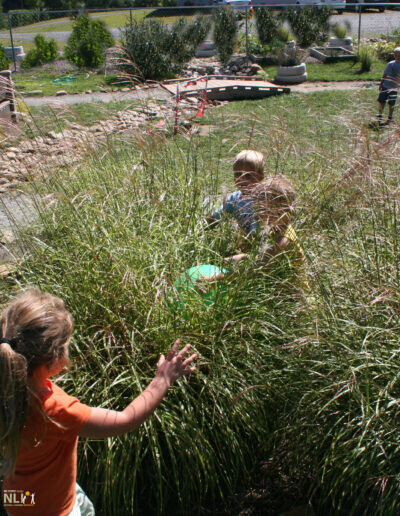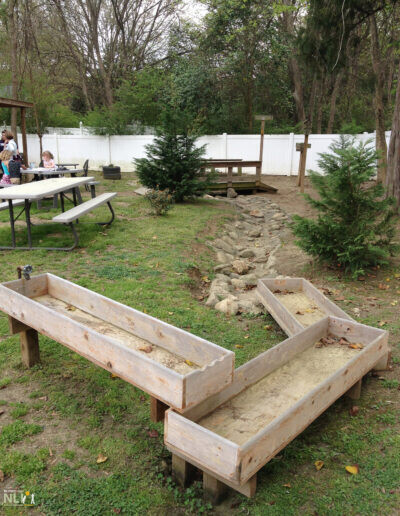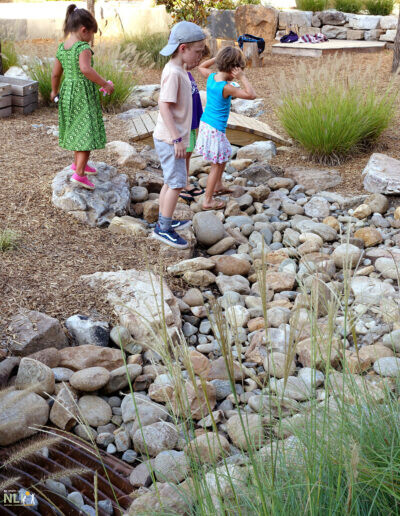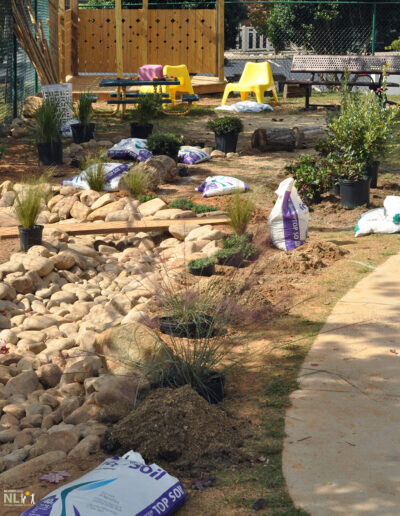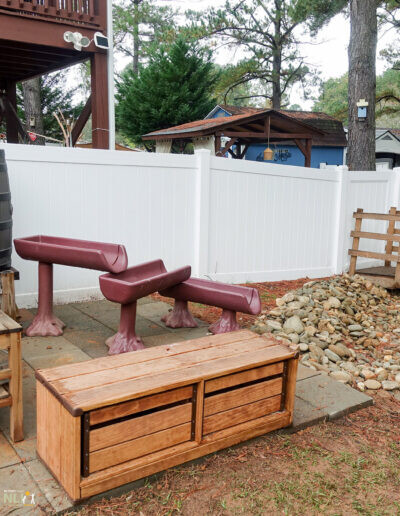36. Dry Stream Beds
location
The most appropriate location is where water flows naturally during a rain or from water play. Mark the natural flow, which may be eroded, with landscaping flags. Make sure the grade is steep enough to avoid ponding. Check that the stream bed does not “empty” into adjacent private property and that water travels away from buildings.
materials
Rocks. Acquire smooth, rounded river rocks from a local landscape supply company. Rocks should vary in shape and size, ranging from 8–18 inches, and sized so that children can turn them over but not pick them up. Consult with suppliers regarding how many stones will be required based on the square footage of the stream bed.
Border plantings. For stream bed edges, hardy perennial grasses such as muhly grass will add texture, a sense of enclosure, and play value. Native grasses can provide much-needed shelter and food sources for bird species. The soft reed juncus is highly recommended for stream bed planting due to it’s hardiness and play high play value.
Landscape fabric is an optional trench treatment. Fabric controls unwanted weeds and prevent rocks from settling too deep into the soil. Landscape fabric can be purchased at local hardware stores.
installation
Dig a trench no more than 12 inches deep in the center, varying from 2–4 feet wide. Design the trench with curves to create a naturalistic look. Ensure that the sides are gently sloped so that children can independently exit.
If landscape fabric is used, lay across in the trench, cutting it to fit the edges. Hide fabric edges with rocks for a natural look. Cut pockets in the fabric to plant juncus between rocks if desired.
Place the largest rocks along the edge of the creek bed. Dig out small depressions and pack them in with soil to prevent movement. Space rocks with gaps in between to accentuate edge.
Place the remaining medium-sized rocks, expanding from the edge of the stream bed and filling in the center around plants (if any). Arrange rocks of different sizes and colors together to create variation.
Install perennial grasses along the edge of the stream bed. Highlight curves and entry points with plantings while ensuring that visibility into the stream is not impaired. Grasses and juncus will do best in full sun. When planting, dig a hole as deep as each plant’s container and 1.5 times as wide. Add a 1–3-inch layer of mulch at the base of the plant without covering the plant itself.
CONNECTING TO A WATER SOURCE
Dry creek beds can be connected to a potable water source, such as a hose or tap, to integrate water play. Standing water is not permissible in most state licensing regulations, so dry stream beds intended for water play need sufficient drainage. Consult with a local landscape architect or engineer to ensure slope is adequate.
HEALTH AND SAFETY
- Before digging on site, call 811 to check for underground utilities. The service is free but can take several days, so call in advance before starting installation.
- Dry stream beds should not be located in infant/toddler play areas. Children must wash hands after coming in contact with “gray water” or other run-off after a storm.
Grasses for dry stream Beds:
- Common rush, Juncus effusus
- ‘Karley Rose’ or ‘Hameln’ Fountain Grass, Pennisetum
- ‘Karl Foerster’ Feather Reed Grass, Calamagrostis x acutiflora
- Little Bluestem, Schizachyrium scoparium
- Muhly grass, Muhlenbergia capillaris
- River Oats, Chasmanthium latifolium

